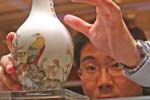Share Your Experience
Haunting beauty of the Huashan
Updated: 2011-03-05 07:37
By Zhao Shijun (China Daily)
At 2,155 meters above sea level, the peak of the Huashan range is the highest of the five sacred mountain groups in China.
But it is not just the altitude that makes the mountains in Huayin, Shaanxi province stand out, especially compared to 8,848-meter Qomolangma and others nearly as tall.
|
Taoists built temples atop the mountains to pursue a life free from worldly worries. |
It is more about the Huashan's importance in human history stretching back thousands of years. The range has rich cultural and spiritual connotations, a place where Taoism flourished for more than two millenniums.
The rugged landscape is among the earliest sacred mountains worshiped by emperors and ordinary people in ancient dynasties.
In the Eastern Zhou Dynasty (770-256 BC), the Huashan were first called the Western Mountains because they lay to the west of Luoyang, then the nation's capital.
They were frequently selected by ancient emperors as the site to offer sacrifices.
A stone stele built in the Qing Dynasty (1644-1911) at the northern foot of the range and numerous other historical records explain why five mountain ranges in China including the Huashan were considered sacred and chosen by emperors as sites for worship.
On the stele, the Huashan resemble a tiger.
|
A trek up the Huashan Mountains has long been adventurous. Meng Hong / for China Daily |
According to ancient Chinese philosophy and mythology, the universe is composed five basic elements.
Metal, which thrives in the west, is represented by a white tiger totem.
The wood in the east is represented by a blue dragon, the water in the north by a black turtle called xuanwu, the fire in the south is symbolized by a red phoenix and the earth in the center is represented by the god of earth.
With their outline forming the shape of a tiger and located in the west, the source of fengshui - or wind and water - for the whole nation, the Huashan seem a perfect recipient of worship.
The mountains also took center stage in ancient culture because they are only about 120 kilometers from Chang'an - today's Xi'an - the capital of many dynasties including the powerful Han (206 BC - 221 AD) and Tang (618-907).
It took less than a day for emperors and officials to ride from Chang'an to Huashan.
But the climb into the mountains was far from easy.
Even today, a hike in the Huashan is said to be one the hardest and most adventurous of the sacred mountain ranges.
During the Tang Dynasty a stairway was built on the face of steep cliffs to reach the summit.
With the trip requiring great effort, devotees could show their determination and piety by making a pilgrimage.
But not every emperor could reach the highest peak. Most wrapped up their trip at the Western Mountains Temple at the foot of the sacred range.
Still intact today, the earliest and biggest of all the temples in the five revered mountain ranges has the layout of the Forbidden City but on a much smaller scale. Locals call it the Shaanxi Palace Museum.
According to historical records, the temple received sacrifices from 56 different emperors.
E-paper

Green light
F1 sponsors expect lucrative returns from Shanghai pit stop
Buying into the romance
Born to fly
Light of hope
Specials

Share your China stories!
Foreign readers are invited to share your China stories.

No more Mr. Bad Guy
Italian actor plans to smash ‘foreign devil’ myth and become the first white kungfu star made in China.

Art auctions
China accounted for 33% of global fine art sales.


